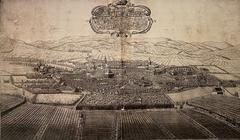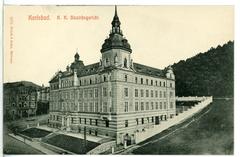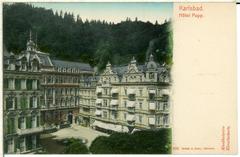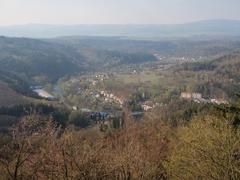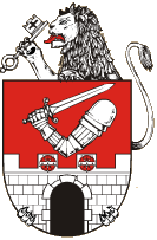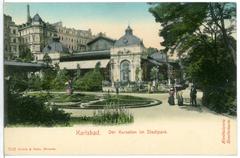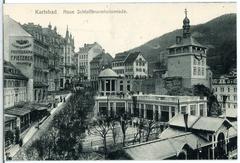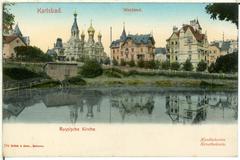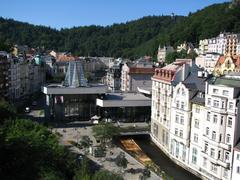
Comprehensive Guide to Visiting Zámek Ostrov, Karlovy Vary, Czech Republic
Date: 01/08/2024
Introduction
Nestled in the picturesque Karlovy Vary region of the Czech Republic, Zámek Ostrov stands as a testament to centuries of architectural evolution and cultural heritage. Initially established in the early 13th century, the site has transitioned through various architectural styles, from its medieval origins to its Renaissance and Baroque splendor. The castle’s historical significance is intertwined with notable families such as the Schlicks, the Saxon-Lauenburg family, and the Habsburgs, each leaving their indelible mark on its structure (Wikipedia). Today, Zámek Ostrov serves as a vibrant cultural hub, housing municipal offices, a library, a gallery, and a museum, while its meticulously restored gardens offer a serene retreat for history enthusiasts and casual visitors alike (iCostrov). This comprehensive guide aims to provide you with all the essential information for planning your visit, from historical insights to practical details on tickets and opening hours.
Table of Contents
- Introduction
- Historical Background of Zámek Ostrov
- Cultural and Educational Significance
- Visitor Information
- Nearby Attractions
- Special Events and Guided Tours
- FAQ
- Conclusion
- Call to Action
Historical Background of Zámek Ostrov
Early Origins and Medieval Period
The origins of Zámek Ostrov can be traced back to the early 13th century. The initial settlement, known as Zlaukowerde, was established by Slauko I Hrabišic. This area, strategically located, evolved into a prosperous market town. The first reliable written mention of Ostrov dates back to 1269 (Wikipedia).
During the reign of King Ottokar II of Bohemia, the settlement gained the status of a royal town. This status was maintained until the 15th century when the Schlick family acquired the town. The Schlicks were instrumental in transforming the original guarding castle into a Renaissance residence at the turn of the 15th and 16th centuries (Wikipedia).
Renaissance and Baroque Transformations
The significant transformation of Zámek Ostrov began under the ownership of Kašpar Šlik, who converted the medieval castle into a Renaissance chateau. This renovation marked the beginning of the castle’s prominence as a noble residence. The Schlick family maintained their residence here for over a century (iCostrov).
In 1625, Julius Henry, Duke of Saxe-Lauenburg, acquired the town and decided to make Ostrov the residence of his house. He initiated extensive reconstruction and expansion of the castle, transforming it into a Baroque palace. This period also saw the establishment of a Piarist monastery with a Latin school, further enhancing the cultural and educational significance of the area (Wikipedia).
18th Century Developments
The 18th century was a period of further architectural and cultural development for Zámek Ostrov. The castle underwent a significant Baroque transformation under the Saxe-Lauenburg and Baden-Baden families. The gardens of the castle, during this period, were considered among the most famous in Bohemia, often referred to as the “eighth wonder of the world” (Karlovy Vary).
19th Century and Habsburg Influence
In the 19th century, Zámek Ostrov came under the ownership of the Tuscan branch of the Habsburg family. This period marked the industrialization of the town, with the establishment of a smelter, a cardboard factory, and a porcelain factory. The castle itself saw further modifications, aligning with the neoclassical architectural trends of the time (Wikipedia).
Modern Era and Restoration
The modern era of Zámek Ostrov began in the mid-20th century. In 1964, the castle was designated as a cultural monument, recognizing its historical and architectural significance. Extensive restoration work was carried out between 2012 and 2014, revitalizing the castle and its surrounding structures. Today, the castle complex serves multiple public functions, including housing the municipal offices, a library, a gallery, and a museum (Wikipedia).
Architectural Highlights
Main Building and Roofed Courtyard
The main building of Zámek Ostrov, with its roofed courtyard, is a central feature of the complex. This area houses the town hall and various exhibitions, including those on the history of the castle and the local porcelain production. The courtyard itself is a testament to the castle’s architectural evolution, showcasing elements from different periods (Wikipedia).
Palace of Princes
The Palace of Princes, also known as the Baden Palace, is another significant structure within the castle complex. This building now serves as the town library and includes Václav Havel’s Orangery, which is used for exhibitions and concerts. The Palace of Princes reflects the grandeur of the Baroque period and the subsequent neoclassical influences (iCostrov).
Castle Gardens
The castle gardens, once renowned as the “eighth wonder of the world,” have undergone various transformations over the centuries. Today, they remain a key attraction, offering a glimpse into the historical landscaping practices and the aesthetic preferences of the Baroque period. The gardens are a serene space for visitors to explore and enjoy the natural beauty and historical ambiance (Karlovy Vary).
Cultural and Educational Significance
Zámek Ostrov has played a crucial role in the cultural and educational development of the region. The establishment of the Piarist monastery and Latin school in the 17th century marked the beginning of its educational significance. Today, the castle continues to serve as a cultural hub, hosting various exhibitions, concerts, and educational programs. The presence of the town library and the gallery within the castle complex further underscores its role as a center for learning and cultural exchange (Wikipedia).
Visitor Information
Opening Hours and Tickets
- Opening Hours: Daily from 9 AM to 6 PM.
- Ticket Prices: Adults €10, Children €5, Family Pass €25.
Travel Tips
- Getting There: Easily accessible by public transport from Karlovy Vary.
- Accessibility: The castle is wheelchair accessible with ramps and elevators.
Nearby Attractions
- Karlovy Vary Hot Springs: A short drive from Zámek Ostrov.
- Moser Glass Museum: Another cultural site nearby.
Special Events and Guided Tours
- Guided Tours: Available daily at 10 AM and 2 PM.
- Special Events: Seasonal festivals and historical reenactments.
FAQ
Frequently Asked Questions
- Q: What are the visiting hours for Zámek Ostrov?
- The castle is open daily from 9 AM to 6 PM.
- Q: How much are the tickets for Zámek Ostrov?
- Ticket prices are €10 for adults, €5 for children, and €25 for a family pass.
- Q: Is Zámek Ostrov accessible for wheelchair users?
- Yes, the castle is wheelchair accessible with ramps and elevators.
Conclusion
Zámek Ostrov is more than just a historical monument; it is a living testament to the region’s rich cultural and architectural heritage. Whether you’re a history buff, a cultural enthusiast, or simply looking for a picturesque spot to explore, Zámek Ostrov offers something for everyone. Plan your visit today and immerse yourself in the enchanting history of Karlovy Vary (Karlovy Vary).
Call to Action
Don’t forget to download our mobile app, Audiala, for more travel tips and updates. Follow us on social media for the latest news and events at Zámek Ostrov.
References
- Wikipedia, 2023, https://en.wikipedia.org/wiki/Ostrov_(Karlovy_Vary_District)
- iCostrov, 2023, https://www.icostrov.cz/zamek-ostrov/
- Karlovy Vary, 2023, https://www.karlovyvary.cz/cs/ostrov
